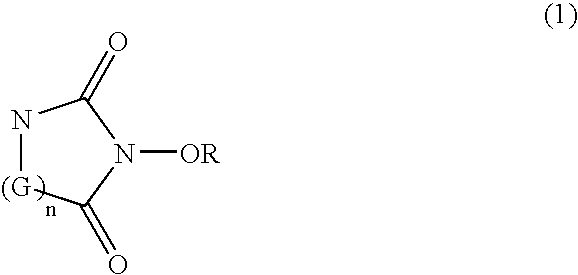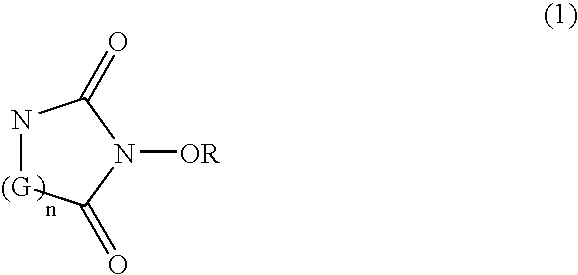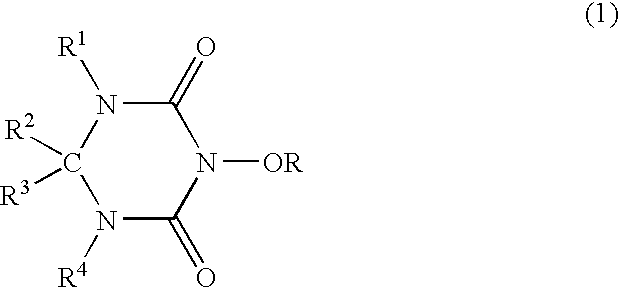Catalyst comprising cyclic acylurea compounds and processes for production organic compounds with the same
a technology of cyclic acylurea and catalyst, which is applied in the direction of organic compound/hydride/coordination complex catalyst, physical/chemical process catalyst, bulk chemical production, etc., can solve the problem that the catalytic oxidation process cannot easily and efficiently produce alcohol or carboxylic acid under mild conditions, and the substrate is decomposed, etc. problem, to achieve the effect of high selectivity and high yield
- Summary
- Abstract
- Description
- Claims
- Application Information
AI Technical Summary
Benefits of technology
Problems solved by technology
Method used
Image
Examples
first embodiment
such production will be described below. By catalysis of the cyclic acylurea compound, an alcohol represented by following Formula (2):
wherein Ra and Rb are the same or different and are each a hydrogen atom or an organic group, where Ra and Rb may be combined to form a ring with the adjacent carbon atom, is allowed to react with (B4-1) oxygen and (B11) an active olefin represented by following Formula (3):
wherein Rc, Rd and Re are the same or different and are each a hydrogen atom or an organic group; and Y is an electron attractive group, where Rc, Rd, Re and Y may be combined with each other to form a ring with the adjacent carbon atom or carbon-carbon bond, and thereby yields a 1,3-dihydroxy compound represented by following Formula (4):
wherein Ra, Rb, Rc, Rd, Re and Y have the same meanings as defined above. This reaction can be performed pursuant to a process (a process using a catalytic N-hydroxy cyclic imide compound) described in PCT International Publication No. WO0...
preparation example 1
Production of 1,3,5-tribenzyloxy-hexahydro-1,3,5-triazine-2,4,6-trione
A mixture of 23.94 g (150 mmol) of O-benzylhydroxylamine hydrochloride, 250 ml of pyridine and 26.76 g (165 mmol) of carbodiimidazole was stirred under nitrogen atmosphere for 1 hour. The stirred mixture was heated at 60° C. for 6 hours and subsequently was heated at 90° C. for 5 hours. After stirring at 90° C. for 5 hours, the reaction mixture was concentrated to 100 g. The resulting concentrated was cooled to room temperature, to this was added 500 g of water with stirring slowly, and the resulting mixture was stirred for 1 hour. The separated crystalline was filtered off and washed with 50 ml of water, 30 ml of acetic acid, and 20 ml of hexane in order, and dried by aspiration for 1 hour. To the resulting crude crystalline with orange color (11.25 g), 80 ml of acetic acid and 70 ml of ethyl acetate were added and dissolved at 100° C. After stirring for 30 minutes, the mixture was cooled to room temperature. ...
preparation example 2
Production of hexahydro-1,3,5-trihydroxy-1,3,5-triazine-2,4,6-trione
2. 50 g (5.59 mmol) of 1,3,5-trybenzyloxy-hexahydro-1,3,5-triazine-2,4,6-trione obtained by preparation example 1 (catalyst) was dissolved in ethyl acetate. To the solution, 5 g of 5% by weight of Pd / C (wet) was added and the resulting mixture was stirred at room temperature for 2 hours vigorously under hydrogen atmosphere. The reaction mixture was subjected to filtration with celite to remove the catalyst therefrom and the filtrate was concentrated. To the residue, 20 ml of diisopropyl ether was added, and the separated crystalline was filtered off and washed with 30 ml of diisopropyl ether and 5 ml of hexane in order. The crystalline was dried at 80° C. for 12 hours under a reduced pressure to yield 1.83 g (92%) of target compound with pale orange color.
1H-NMR (DMSO-d6, 500 MHz) δ: 11.03 (brs, 3H, OH)
13C-NMR (DMSO-d6, 125 MHz) δ: 146.8
MS (FAB+) m / z 176 ((M−H)−, 100), 160 (56), 117 (9), 101 (9...
PUM
| Property | Measurement | Unit |
|---|---|---|
| Time | aaaaa | aaaaa |
| Metallic bond | aaaaa | aaaaa |
| Selectivity | aaaaa | aaaaa |
Abstract
Description
Claims
Application Information
 Login to View More
Login to View More - R&D
- Intellectual Property
- Life Sciences
- Materials
- Tech Scout
- Unparalleled Data Quality
- Higher Quality Content
- 60% Fewer Hallucinations
Browse by: Latest US Patents, China's latest patents, Technical Efficacy Thesaurus, Application Domain, Technology Topic, Popular Technical Reports.
© 2025 PatSnap. All rights reserved.Legal|Privacy policy|Modern Slavery Act Transparency Statement|Sitemap|About US| Contact US: help@patsnap.com



